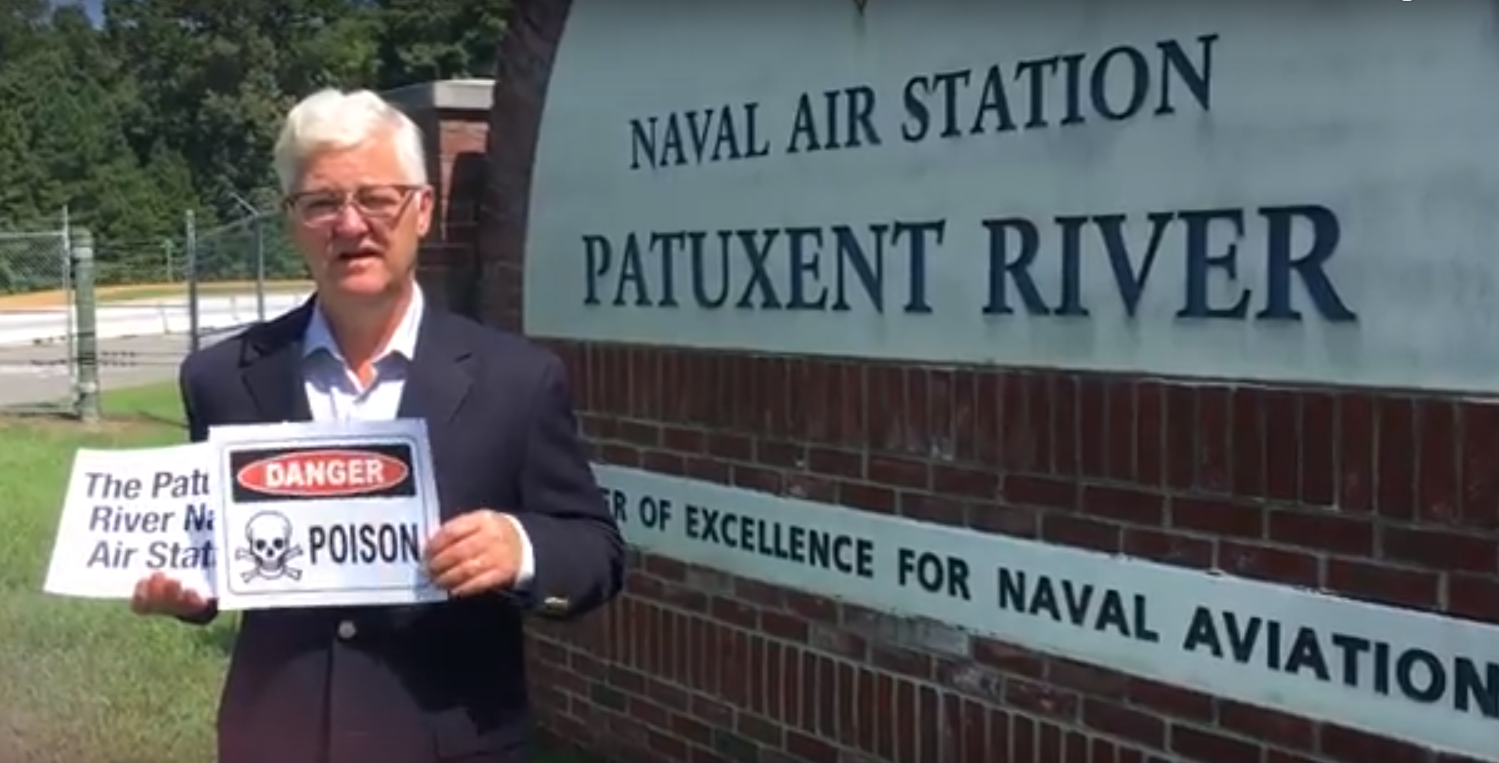
The author at the entrance to the Naval Air Station.
Pathetic Performances from Federal and State Officials Distort the Truth
Pat Elder / Military Poisons
PATUXENT MD (May 3, 2021) — Presentations by Navy and Maryland officials on PFAS contamination at the Patuxent River Naval Air Station and Webster Outlying Field in St. Mary’s County, Maryland distorted the truth regarding the health impacts of these dangerous chemicals in use on naval facilities.
The presentations were part of the Navy’s virtual Restoration Advisory Board (RAB) meeting on April 28, 2021 to address community concerns regarding recent revelations of high levels of PFAS contamination in groundwater at the two bases. PFAS are dangerous per-and poly fluoroalkyl substances the Navy has used in fire-fighting foams and other applications since the early 1970’s. PFAS in the tiniest amounts is linked to a host of cancers, fetal abnormalities, and childhood diseases.
The online production by the Navy provided the community its first opportunity to hear from the Patuxent River command since 275 people packed into the Lexington Park library in early March, 2020 to hear the Navy address their concerns about the quality of the seawater and levels of contamination in the seafood. Many left that meeting saying they were unhappy with the answers to their questions. They left saying many of their questions were unanswered. It’s the same this time too, although the Navy chose Microsoft Teams, a difficult to navigate platform that did not provide a count of the participants.
===================

The Navy’s Dog and Pony Show – Cast of Characters
David Steckler, Remedial Project Manager, Naval Facilities Engineering Systems Command (NAVFAC), Washington. This was Steckler’s show. The following cast played a supporting role:
Jenny Herman, Remedial Project Manager, Maryland Department of the Environment (MDE) Ms. Herman was the leading confidant.
Captain John Brabazon, Commanding Officer, NAS Patuxent River
Patrick Gordon, Public Affairs Officer at Naval Air Station Patuxent River
Andrew Sochanski, Remedial Project Manager, U.S. Environmental Protection Agency (EPA)
Heather Moritz, St. Mary’s County Health Department (Maryland Department of Health, MDH)
====================

I have communicated with two dozen who attended the meeting and they weren’t impressed with the performance of the federal and state officials.
“It seemed like they were following a script,” said one. Another said the presentations were callous and disconnected. One said the Navy is more concerned with adhering to the protocol they’ve developed than protecting public health. “They seemed agitated, uncomfortable with their roles, and on the defensive,” said a local resident. Others were tougher. A retired EPA official remarked, “They’re contaminating our rivers and our food and they know it. Meanwhile, they take no responsibility for it.” “They were as disconnected as human beings can become,” said another. This is not a cheap shot. It is the truth.
Local, regional and national press aren’t covering this story. .
In this analysis:
Captain Brabazon’s Intro
Steckler Recites the Navy’s Line
Seafood Contamination
Groundwater Contamination at Webster Field
Role of St. Mary’s County Commissioners
Role of MDE
Role of EPA
Incineration
Unanswered Questions
==========

Captain Brabazon takes command of Patuxent Naval Air Station
Captain John Brabazon’s Introductory Remarks
The commanding officer began his remarks by stating, “First and Foremost, the drinking water is safe.” An accompanying visual said the Navy has “prioritized the protection of drinking water.”
The military has been steering the discussion of PFAS toward drinking water for many years. That’s because they can filter drinking water systems and declare victory. Meanwhile, food – especially seafood, is the number one pathway to human ingestion of PFAS. The European Food Safety Authority (EFSA) says seafood accounts for up to 86% of dietary PFAS exposure in adults. All that matters to the DOD is the potential liability it faces for its reckless behavior. They’re trying to steer the conversation away from poisoned surface water and sea food.
The DOD and the EPA are both fixated on the drinking water. The EPA plays a largely subservient role to the DOD. It’s the world we live in. Eisenhower warned us about it.
The Pentagon has managed to escape liability for its environmental crimes by controlling the media and working to diminish public concerns largely through delay tactics. This approach is from the military’s playbook. It is used in communities nationwide. This psy-ops campaign has been effective in muting community concerns almost everywhere.
Both the Navy and the St. Mary’s County Metropolitan Commission have likely brought PFOS/PFOA levels under the EPA’s advisory of 70 ppt., although we don’t have fresh data confirming this. Enough on the drinking water.
Captain Brabazon said Pax River will be looking into “where PFAS may have been released.” Like the statement about the water above, this is intentionally misleading. The Navy knows exactly where the substances have been used and burned and buried and discarded and shipped from the base. They try to make it sound like this is a novel situation, but their intention, here, and at naval facilities everywhere, is to drag it out so long that the public’s scant attention to the matter is snuffed out.
Hopefully, they’ll hold another RAB meeting in two weeks or so. We’ll need at least that much time to organize for it. Members of the community have lots of compelling questions that remain unanswered. Many are upset and they have good reason with the levels of contamination recently reported by the Navy.
It was shameful how Pax River, under Brabazon’s command, only gave the public three days to submit questions for this meeting. Also, the command ought to hold the next RAB on Zoom. Six people told me they could not get through on Microsoft Teams. Pax River ought to release the number of folks who attended the meeting, along with the questions they submitted.
David Steckler, Remedial Project Manager, NAVFAC Washington
David Steckler began his presentation by saying, “Not surprisingly, the Patuxent NAS is a source of PFAS contamination.”
The Navy has become so smug its chief spokesman on PFAS can lead off a public event saying its not surprising that their two bases in St. Mary’s County are contaminating the environment. This too, is part of their psychological campaign being waged against the public. They continually plant the seed of a thought that PFAS is commonplace. They’re trying to elicit a giant shrug of the shoulders from us while they continue to use the substances on their bases.
Steckler said the Navy is only testing for 18 types of PFAS. Meanwhile, commercial testing firms like Eurofins regularly test for 36 toxic PFAS compounds. The naval command has failed to release its testing results beyond the astronomical numbers we’ve received regarding PFOS, PFOA, and PFBS. Where are the results for the other 15 types of PFAS they tested – and can we expect the base to test for all 36? Steckler said if the EPA adds more PFAS contaminants to test the Navy will test them.
The Navy’s Remedial Project Manager pressed the EPA theme the entire hour. After all, the Navy hasn’t done anything wrong. The EPA says so.

Seafood
Remedial Project Manager Steckler said the Navy has no plans to test fish for PFAS because the EPA doesn’t call for testing.
We understand the Navy accepts no responsibility for its actions, but the EPA’s lack of attention to this issue is also criminal. In essence, the EPA is saying that oysters containing 2,070 ppt, crabs with 6,650 ppt and rockfish with 23,100 ppt of PFAS caught close to Webster Field are not a concern.
Because of the EPA’s stance, the Navy, the MDE, and the MDH say there’s no problem regarding PFAS in seafood in Maryland. Actually, the test results of fish at Webster Field are miniscule compared to the larger bases like Pax River where an oyster was found to contain more than a million parts per trillion of PFOS. Here are some totals of PFOS found in oysters in Maryland.
====================
Perfluorooctane Sulfonate (PFOS) in Oysters, Crassostrea Virginica , from the Gulf of Mexico and the Chesapeake Bay, USA
Location PPT of PFOS
Chesapeake Bay Hog Point MD 1,106,000
(Patuxent River NAS)
Potomac River Swan Point MD 59,000
Chesapeake Bay Choptank River MD 59,000
Chesapeake Bay Mountain Point 50,000
Chesapeake Bay Bodkin Point 43,000
Chesapeake Bay Hackett Point Bar 56,000
May 2002 Archives of Environmental Contamination and Toxicology 42(3):313-8 PFOS in Oysters Crassostrea Virginica

========================
The Hog Point oyster was collected near the Navy’s release of foams from an overhead suppression system of the hangar that houses the Joint Strike Fighter force of F-35’s. The other oysters were not collected close to naval facilities.
There has been precious little official testing of fish in DC and Maryland. The US Geological Survey found PFAS levels of 574,000 ppt in a Smallmouth Bass near the historic bridge at the Antietam Battlefield in Western Maryland. Perhaps the DOD could enlist the help of the USGS to sample the seafood near military installations in the Potomac and the Chesapeake. They could start by testing at NAVFAC’s headquarters at the Navy Yard on the beautiful but heavily contaminated Anacostia River.
The DC Government has banned eating eel, carp and striped bass from the waters in front of NAVFAC’s headquarters but it says people may catch and consume four servings per month of sunfish, or three servings per month of blue catfish or white perch, or two servings per month of largemouth bass, or one serving per month of brown bullhead catfish or channel catfish. Perhaps NAVFAC could step to the plate and test fish at the Navy Yard for PFAS to make sure their activities aren’t further endangering the community.
It ain’t gonna happen.
Fish have been found near military installations containing nearly 10 million parts per trillion of the chemicals. The most contaminated fish was caught near Wurtsmuth AFB in Michigan where the state tested 2,841 fish throughout the state and found an average reading of 93,000 ppt for fish. We’re not supposed to be consuming more than 1 ppt of the chemicals in drinking water, public health officials caution.
A couple of bites from a tasty baked fish with 10 million parts per trillion of PFAS exceeds the PFAS someone may consume while drinking water containing the EPA’s advisory of 70 ppt every day for a 90-year lifetime. The EPA is OK with all of this. The Environmental Protection Agency is not protecting us. It is protecting the military.
Steckler on Webster Field
In response to a question regarding plans to “remediate” the contamination at Webster Field, Steckler said, “It’s too early to say when Webster Field will be cleaned up.”
This is another line straight out of the Pentagon’s playbook. They use this approach everywhere. Without the media playing its crucially important role, the public doesn’t have a prayer in deciphering much of this. The Navy started testing at the Pax River facilities in 2016. They’ve known the region is heavily polluted since 2016.
What would happen if hundreds of protesters from the region showed up at Webster Field on Villa Road in St. Inigoes to demand accountability? Would that dislodge the Navy’s intransigence?
The Navy must be interrupted. This cannot become business as normal in St. Mary’s.

County Commissioner Todd Morgan (left) greets Maryland Gov. Larry Hogan
St. Mary’s County Commissioner Interrupts Dog and Pony Show
It’s instructive to read this exchange between St. Mary’s County Commissioner Todd Morgan and David Steckler when Steckler addressed (42:55-) the St. Mary’s County MD Commissioners on PFAS at Pax River on December 8, 2020.
Morgan — Obviously, there’s quite a number of people concerned about the PFAS contamination levels throughout the county.. So, I’m wondering, you say you’ve got the data. So, are we waiting till March to get this data released? They’re kind of edgy in some areas of the county, particularly some of the watermen, some of the residents. I was at the last briefing a couple of months ago and obviously, it was a little contentious. I don’t see.. when some better answers may be available for the residents to try to help them with their concerns.
Steckler We are certainly very aware of the public concerns and, in fact, in my next slide, I address a little bit of that, so if we can move on and look at this slide and go through it.
Morgan (Interrupting..) Can you tell us when you started the investigations?
Steckler 2018 is when we completed the preliminary assessment (PA) … We initiated the PA at Pax River in 2016.
Morgan So we started in ’16. We did something new in ’18 and then we did more studies in ’20 and maybe we’ll get a report in ’21. I’ve got that right in my head?
Steckler – That’s correct. The CERCLA (Comprehensive Environmental Response, Compensation, and Liability Act) process is not the fastest process. We work very closely with our regulatory partners. We have to address all of their concerns before we go out to the public and because of that, it tends to take time.
We do the field work, we send the results to the lab. The lab takes 28 days to analyze it, then we have another two weeks to have the data validated by a third party and then we begin to look at it and that takes time.
Morgan – From the time you collect it and do the data that is 6 weeks. If I just did my math correctly, we’re still looking at five years… 6 weeks? I’m just asking questions that the residents and the watermen ask me, so I’m just bringing it up.
Commissioner Morgan had to interrupt Steckler. See how this works?
During the virtual RAB meeting on April 28 Steckler said there was no evidence of any risk to public health from the PFAS contamination at Webster Field. Although many communities around the country might buy it, there are too many here who have been following this. Things will play out differently for the Navy here in St. Mary’s County, Maryland.
In response to a question about testing protocols, Steckler said that EPA Method 537.1 is the only approved method for testing seafood. That method was used by the scientists we hired at Eurofins who found oysters containing 2,070 ppt, crabs with 6,650 ppt and rockfish with 23,100 ppt of PFAS.
The MDE, MDH, EPA and the Navy have not addressed these findings and they haven’t tested the seafood themselves, except for the bogus oyster report published by the MDE covered below.
The water at my beach on St. Inigoes Creek, directly across from Webster Field, contained 1,894 ppt of PFAS, including 1,544 ppt of PFOS. The analysis was performed by the University of Michigan’s Biological Laboratory using EPA Method 537.1. The foams regularly collect on my beach. They largely come and go with the tide. The release sites on base, 1,800 feet from my property, reported a total of 92,377 ppt of PFOS, PFOA, and PFBS in groundwater leaching into the creek. Of that, PFOS totaled 84,756 ppt.

PFAS foam gathers along St. Inigoes Creek 1,800 feet from where the substances were routinely tested.
Is it really a stretch to suggest that the Navy has caused the contamination on my beach?
The Maryland Department of the Environment says the contamination I reported likely came from a firehouse five miles away or a landfill eleven miles away. They’re partners with the DOD.
When asked if the Navy would be willing to fund local epidemiological studies Steckler said there was no evidence of the health effects of PFAS to warrant the testing.
Epidemiological studies are a good thing and they can prove a lot. The Navy is afraid of what they’ll find down here.
Thousands of people working at Pease International Tradeport, along with children and infants who attended two day cares there, were exposed to multiple PFAS chemicals contaminated by firefighting foam used at the former Pease Air Force Base. That base was found to contain 96,900 ppt of PFAS in the groundwater. Webster Field has 92,377 ppt. in its groundwater.
In 2015, New Hampshire began a blood testing program for people who had lived on, worked on, or attended child-care on the facility. (Children are particularly vulnerable to these chemicals.) A total of 1,578 individuals had their blood tested for PFAS between April to October 2015 and most were found to have dangerous levels of the toxins in their blood. A federal health study on adults and children exposed to dangerous PFAS chemicals is currently being conducted by the Centers for Disease Control and Prevention and the Agency for Toxic Substances and Disease Registry for the folks in New Hampshire, but not Maryland. This would be unlikely because it would require Maryland’s congressional delegation to become involved. They’re also partners with the DOD.
The Role of the Maryland Department of the Environment in Regulating PFAS (Spoiler — They Don’t Regulate the Substances)
The MDE is an enabler of the DOD. In psychological parlance, a person who encourages or enables negative or self-destructive behavior in another is an enabler. The Navy calls MDE a “partner”.

The MDE and Oysters and Deer
Jenny Herman, Remedial Project Manager, Maryland Department of the Environment, (MDE) said the levels of PFOS are “below levels of concern” in oysters. The MDE knows that oysters near military installations can contain a million parts per trillion of PFAS and that’s OK with them.
Now, stop for a second. Who are you going to believe? — the Maryland Department of the Environment, the United States Navy, the Environmental Protection Agency, and the Maryland Health Department – or me?
You ought to believe me. I’m telling the truth.
In September 2020, the Maryland Department of the Environment (MDE) released a report entitled “St. Mary’s River Pilot Study of PFAS Occurrence in Surface Water and Oysters.” (PFAS Pilot Study) that analyzed the levels of per-and poly fluoroalkyl substances (PFAS) in seawater and oysters. Specifically, the PFAS Pilot Study concluded that although PFAS is present in tidal waters of the St. Mary’s River, the concentrations are “significantly below risk based recreational use screening criteria and oyster consumption site-specific screening criteria.” Few I consulted in academic and regulatory circles were quite sure what this means.
The MDE published this report using Alpha Analytical, a company that had to pay a $700,000 fine to the state of Massachusetts because the state found the company mislabeled containers of hazardous waste, failed to take required safety precautions, and improperly operated a wastewater treatment system.
While MDE’s report says the oysters are OK, the analytical methods and basis for the screening criteria used by MDE are questionable, resulting in a misleading of the public, and providing a deceptive and false sense of safety.
The tests performed by Alpha Analytical Laboratory had a detection limit for oysters at one microgram per kilogram (1 µg/kg) which is equivalent to 1 part per billion, or 1,000 parts per trillion. (ppt.) Consequently, as each PFAS compound is detected individually, the analytical method employed was unable to detect any one PFAS present at an amount of less than 1,000 parts per trillion.
(Researchers with Harvard University’s Public School of Health say we shouldn’t be ingesting any of these chemicals. They call for limiting drinking water to 1 part per trillion of the chemicals.)
One has to wonder why MDE hired Alpha Analytical to manage the PFAS study if the detection limits of the methods used were so high.
Don’t eat the oysters.
When asked if the seafood is OK to eat, MDE’s Herman said she is not aware of largescale studies of fish in this area. The state’s top regulatory agency, charged with instituting studies to ascertain the threat to public health from potential sources of contamination, says the fish are OK to eat because there are no studies suggesting the fish are dangerous.
Herman said the St. Mary’s River Pilot Study found concentrations of PFAS in the river between 2 ppt to 13 ppt. a level they claim is “significantly below risk based oyster consumption site-specific screening criteria.”
The Wisconsin Department of Natural Resources warns that levels above 2 ppt in surface water are cause for alarm because of the propensity of the chemicals to bioaccumulate in fish. How can the state of Maryland, in good conscience, say the quality of the water in my river is just fine and dandy?
The St. Mary’s River has 13 parts per trillion of the poisons in the water while the maximum permissible level for PFAS in the European Union is a hundred times lower, at .13 parts per trillion in seawater.
Herman was asked what percent of the state’s 3,653 public water systems have been tested for PFAS. Several states have tested all of their public water systems. They’ve shut down wells and they’ve set maximum contaminant levels as low as 13 parts per trillion for some PFAS. Not the Old Line State.
Herman didn’t know the answer, and she promised to get right back. There is no new information on the Navy’s RAB site. We shouldn’t have to wait too long.
In January, 2021, the MDE said it will have sampled 137 public water treatment systems for PFAS compounds by the end of February, but that’s less than 4% of the state’s 3,653 public water systems. We haven’t heard from the MDE on this since then and we don’t have any results.
Herman was also asked about the possibility of the state testing sewer wastewater and sludge for PFAS and she promised to get back about that as well.
Someone asked if it was OK to eat deer meat caught near the bases.
Consuming deer meat is prohibited near Wurtsmuth AFB in Michigan, a base that closed in 1993. The deer drink from the groundwater that runs into springs, lapping up the toxins that still seep from the shuttered base. The deer meat is poisonous. Webster Field’s groundwater contamination is worse the Wurtsmuth’s. Maybe Maryland officials know something the Michigan officials don’t know.
Herman said the Webster Field groundwater is brackish, an unlikely drinking source for deer. Actually, deer can tolerate much higher levels of salinity. This is almost as outrageous as the statement by David Steele, Commander of the US Marine Corps Futenma Air Base in Okinawa, who said, “If it rains, it will subside” after a massive release of PFAS-laden foam contaminated waterways and sent foam bubbles 100 feet into the sky on that poisoned island.
Don’t eat deer meat caught near the bases.
We’ll only know the truth if an independent entity tests the deer meat. We can’t trust the MDE to do it. They’re partners with the DOD.
Responding to a question about how to treat contaminated groundwater, Steckler mentioned the “pump & treat” method, when groundwater is extracted via pumping from wells and treated. This approach, however, will not work well if the contaminated groundwater plume is migrating outside of the two naval facilities, a likely outcome considering the Navy has been using these chemicals on base for 50 years.
Pump and treat can be compared to jabbing a few drinking straws into a watermelon the size of an aircraft carrier to extract and treat poisons.
The pump and treat process typically results in PFAS being captured by carbon filters that must be disposed of and no one is sure what to do with it. We can’t bury it in landfills and we can’t burn it.
There’s no end game with these chemicals, and this is something the public doesn’t understand. This stuff is a very real threat to all of us, while the Navy, the EPA. the MDE and the MDH are doing their part to keep us in the dark.
The homes in St. Inigoes that share the south side of the creek with the Navy ought to have their wells tested.
The slides presented to the public claim that the poisoned groundwater at Webster Field discharges to nearby streams and rivers, just like the command says the contamination on the larger Pax River facility drains into the Patuxent River and the Chesapeake. The Navy refuses to acknowledge the possibility that privately owned wells in St. Mary’s County might be contaminated with PFAS like thousands of wells across the country that have been contaminated by the Navy in places like: Kitsap-Bangor, Cutler Fire Station, Whidbey Island, Oceana, Fort Worth, Pensacola, Calverton, Warminster, Willow Grove, Houlton, Kennebunk. That’s just the first two pages of a google search.
News stories about the Navy’s PFAS contamination around the country paint the same story of the Navy dragging its feet, refusing to accept responsibility, and saying it is waiting for direction from the EPA regarding testing and remediation.
The slides presented by the Navy said the deeper groundwater at Webster Field is protected by thick clay layers that isolate drinking aquifers from surface releases. This may, in fact, be the case, however, a prudent investigation would hold out the possibility that the widespread contamination of the surficial aquifer might reach the lower aquifer where people in St. Inigoes and beyond draw their well water. Pump tests in the St. Ingoes/St. Mary’s City area would determine if there is communication between the two zones.
Consider the following exchange between Peggy Williams of the Maryland Department of the Environment and Ryan Mayer of NAVFAC in Washington in 2017 regarding the same issue in Chesapeake Beach pertaining to the 241,000 ppt of PFAS contaminating the groundwater by the Chesapeake Bay Detachment of the Naval Research Lab in Chesapeake Beach. Williams is doing her job well.
Although the Navy claimed the contamination from the surficial aquifer could not reach the lower aquifer, three of the small number of wells the Navy tested in the neighborhood adjacent to the facility, where fire-fighting foam has been tested since 1968, showed the presence of PFAS in the drinking water. The Navy never announced the amounts present and they did not publicize the specific contaminants. Although most homes close to the base have wells, they have not been tested by the Navy. The MDH has been unresponsive.
Peggy Williams/MDE — “The Navy states that the domestic wells north of the Naval Research Laboratory – Chesapeake Bay Detachment are “believed to be screened in the Piney Point Aquifer,” and that this is below a confining unit, “believed to be laterally continuous and fully confining.” Furthermore, the Piney Point aquifer is generally known as a “naturally protected confined aquifer,” according to Source Water Assessment Reports of the area. After reviewing this literature, the Department agrees that these domestic wells are likely drawing water from the Piney Point/Nanjemoy system, but that it cannot be definitively stated that this zone is under a fully confining and laterally continuous unit.
The only way to make that determination would be to conduct pumping tests to check for interconnectivity between shallower wells screened in the unconfined zone and deeper wells under the unit believed to be confining and laterally continuous. Pumping tests for this purpose do not appear to be included in the scope of work in this SAP (Sampling and Analysis Plan). If the Navy conducted these tests to show quantitatively that no communication exists between the two zones, then it could be confidently stated that no migration of potential PFCs is possible between the shallow water bearing units and the Piney Point/Nanjemoy system. This would be an added conservative measure, in addition to samples showing non‐detect PFC results in off‐site private wells.”
Ryan Mayer of NAVFAC — “Not sure I would support pump tests should this increase the risk of potential contamination from one aquifer to another.”
RESPONSES TO COMMENTS REGARDING DRAFT SAMPLING AND ANALYSIS PLAN SITE INSPECTION FOR PERFLUORINATED COMPOUNDS IN GROUNDWATER NRL CHESAPEAKE BEACH MD 1/18/2017 CH2M HILL
We may never know how many more of the wells of people in Chesapeake Beach are being poisoned by the Navy. The two federal and two state entities are co-conspirators in a great environmental crime. We may never know if the folks in Hermanville near Pax River or the people in St. Inigoes are being poisoned. We may never trace liver or kidney cancer in the community to the chemicals and we may never link Johnny’s ADHA or Asthma to PFAS if the state and federal governments continue to look the other way. Grownups need to get involved.

Incineration of PAX River’s PFAS Materials
Steckler was asked if Pax River had sent PFAS materials anywhere to be incinerated. He replied, “Not to my knowledge.”
On 11/12/2018 Pax River shipped 1,035 pounds of plastic drums with PFAS contaminants to be incinerated in Cohoes. NY. Altogether, bases from 25 states sent more than 2 million pounds of PFAS materials to be incinerated.
I broke the story about the specific military sources of 2 million pounds of PFAS materials that were incinerated in Cohoes and sent a brief summary of the story and a spreadsheet to 40 outlets across the country. The Times Union, near Cohoes picked up the story. Their readers breathe the toxins. 40 regional and national news outlets passed on the story while I thought it should be on the front page of the New York Times. (Keep sending me stuff.)
I did send the story to 2,400 on my list – about half in Maryland. There’s a steep learning curve here, and a lot of folks are following it.
The RAB slides said the Pax River command sent a draft report on its PFAS findings to its “regulatory partners” in March, 2021 and has received “regulatory comments”, presumably from EPA and MDE. The public should be given access to these records now. Too bad the EPA and the MDE aren’t less partner and more regulatory. The DOD is driving the “regulatory” train and it can do whatever it wants. There is hope in the Maryland General Assembly to lean on the MDE and MDH next year.

The purple dots from the map show military installations with PFAS releases. Maryland has a high concentration of contaminated military sites. Environmental Working Group
Unanswered Questions
The Navy and its partners sort of responded to 10 of at least 30 questions that were submitted by several dozen attendees. The authorities didn’t respond to these 20:
To the Navy:
1. Why does the Navy call PFAS “chemicals of emerging concern” when they knew they were dangerous in the 1970’s?
2. Is it OK for the children on the beach on St. Inigoes Creek to play in the foam that regularly accumulates there?
3. Is it OK to eat the crabs? Do you accept any responsibility for the contamination of the crabs which I’ve eaten all my life but won’t anymore?
4. Have you done any studies linking PFBA to terrible COVID outcomes? The crabs in St. Inigoes Creek were found to contain 800 ppt. Where else could the PFAS contamination be coming from? Your buddies at the MDE say it’s probably coming from the St. Andrews Landfill 11 miles away.
5. Are you prepared to release PFAS testing results of Harper Creek, Pearson Creek, Goose Creek, the Patuxent River, and the Chesapeake Bay?
6. Joint Strike Fighter Aircraft Hangar 2133 shown in slide 41 shows a maximum concentration of PFOS at 135.83 ppt and a maximum concentration of PFOA at 1138.18 ppt. There have been multiple releases of aqueous film-forming foam (AFFF) in 2002, 2005, and 2010 from the suppression system in the hangar. In at least one incident the entire system inadvertently went off. Are the levels reported at Pax River commensurate with groundwater results for PFAS found where these frequent mishaps have occurred at other military facilities?
7. Uses of AFFF in firefighting and fire suppression systems are considered to have the greatest potential for release of PFAS to the environment. PFAS levels are orders of magnitude higher at other similar – sized installations, often because of discharges from overhead suppression systems. Shouldn’t Hangar 2133 be retested by an outside firm or must all of the testing be done under the Navy’s ultimate control?
8. How many times did you test the overhead system at Hangar 2133 and how many gallons of AFFF were used?
9. How many gallons of AFF have been sent into Metcom’s sanitary sewer system from all of the hangars?
10. Why wasn’t Patuxent River NAS included in the DOD’s report, “Addressing Perfluorooctane Sulfonate (PFOS) and Perfluorooctanoic Acid (PFOA) Maureen Sullivan Deputy Assistant Secretary of Defense (Environment, Safety & Occupational Health) March 2018?”
==============

The Navy relies on The EPA’s “see no evil, hear no evil, speak no evil” policy on PFAS contamination of surface water and seafood. The DOD’s liability is too great for the EPA to blow the whistle.
To the EPA:
11. To what degree is the astronomical liability facing the DOD for its reckless use of PFAS – while knowing it was a killer – informing your decisions regarding the regulation of the substances?
12. Why doesn’t the agency consider all PFAS as hazardous substances and begin regulating them?
13. Is it OK for us to eat the oysters, fish, and crabs caught near the Webster Field base? Is it OK at the Pax River base? Is it OK near any naval facility, here, or anywhere on earth?
14. Is it OK for children to play in PFAS foam?
To the MDE:
15. The US Geological Survey found PFAS levels of 574,000 ppt in a Smallmouth Bass near the historic bridge at the Antietam Battlefield. People eat this fish. Women who are pregnant or may become pregnant eat this fish. Levels of PFOA at .1 part per trillion are deemed to be dangerous while the chemicals are known to impede fetal development and they’re linked to a host of childhood diseases. Are you going to warn these women?
16. Many states have tested surface waters for PFAS. Have you? If not, are you planning to do so?
17. Many states are testing wastewater and sludge for PFAS. Have you? If not, are you planning to do so?
18. Are you planning to set Maximum Contaminant Levels (MCL’s) in drinking water? How much longer do you think this will take? Many states are setting limits for 5 types of PFAS under 20 ppt. Maryland is behind most states in regulating PFAS. Why is that?
19. Will the state soon develop a program to provide for the testing of private wells within a few miles of military and industrial sites that are known to contaminate groundwater with the substances?
20. Will you ban the incineration of PFAS in the state and will you ban the transport of PFAS? The stuff winds up being burned or buried. Either way, people are getting sick.
Last Questiona: to the MDH — Do you consider your agency to be a player in all of this — or just a spectator? People are giving me a hard time about the length of these pieces. In the absence of the fourth estate, this is the public record.